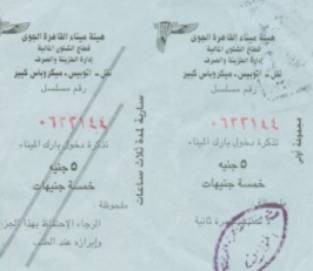
Trip to Alexandria – September 2000
Foreword
I left Alexandria, to come to Rome, in February 1957 and although I could have gone back on many occasions, I never wanted to. The memory of the events, which I always considered an injustice, was too painful: just because we belonged to a different nationality we had been sent away from the country where we were born and grown up. We did not have anti-Egypt feelings and Italy did not carry out an anti-Egypt political or military role. Why did they practically strip us of all our possessions? Why did they sequester the oil tanker ship belonging to my father? Why did they come to our home and try to sign me up in the army? Why was my sister insulted, at “Muhatta Ramleh” because she had blond hair? Why did the border police sequester my stamp collection I had started when I was only eight years old?
But time heals all wounds and gives an explanation to the events. At that time the Egyptian were not in a condition to split hairs; they simply could not stand the economic and cultural superiority of the Europeans, the lid blew off the pot.
I am very happy that I returned to Alexandria, the city is beautiful and the people are kind and generous and it makes even clearer why we lived so well in it. I think often of that trip and relive in my mind the sensations I felt. My heart came back from Alexandria full of love and tenderness. Alexandria is a city which was formed and developed over the centuries by the contribution of different cultures each of which left a distinct and visible mark on it and this is true both for the city and for its inhabitants. This characteristic, practically unique in the world, must be borne in mind whenever one talks or thinks about Alexandria, only this way it is possible to understand why it is so easy to find a piece of this city in all of us.
Arrival In Cairo
The Cairo airport is like a cheerful “souk” in comparison to what that international airport is expected to be. There is still a lot of work to be done both in the infrastructure as well as in the quality of services. Announcements are both in Arabic and English but are nevertheless incomprehensible due to excessive echoing and, when in competition with the prayers broadcast of the “muezzin”, failing to engender the necessary concentration. The bank clerk is more interested in balancing his accounts than looking after me, the customer, and tries to flog me a pile of French coins saying that they are just as good as dollars. On the other hand, the service to and from the planes on the tarmac is excellent and uses vehicles large enough to avoid the “sardine cramming” that we are used to in our airports like Fiumicino, Linate and Malpensa.
After passport control, carried out by efficient and courteous officers, we are approached by an individual with an official looking badge on his chest who, in addition to helping me record my video camera on my passport (the only real help), proceeds to inform me that he, as an employee of the Tourism Ministry, would save me a lot of money if I purchased through him all tickets for admission to museum, taxis, restaurants, hotels etc… Since the hotels were prepaid from Italy, I only ask for a cab.
The man, young and tall with a small moustache meant to denote seriousness, looks dejected but continues his job in earnest. He starts by offering me a large car, seeing that there are five of us and asks for 85 Egyptian pounds. I take him at his word and hand him 90 expecting some change that somehow becomes “baksheesh”. He then takes us outside where we are literally submerged by a horde of screaming people offering various services. Our escort tries to get us into a small car, however subsequent to my protests, a “large car” arrives and I notice that the driver is handed only ten pounds. I am too tired and disoriented to intervene and anyway all of a sudden our escort gets an attack of amnesia and can no longer speak English.
The “large” car is an old black landau, fitted with curtains that used to be white on the car windows, that for one and a half hours bounces us through the centre of Cairo towards Ghiza.
It is midnight, it’s late, but not for the “Cairots”: kids pushing their hand through the car windows asking for “baksheesh”, loads of hawkers but primarily an incredible number of people, dressed in the most disparate of fashions, promenading and enjoying the cool of the evening. The streets are so crowded that one has the impression that shoulders and elbows are necessary to move through the crowd. On the bridges over the Nile a lot of people are fishing and young couples hand in hand gaze at the river or at the moon. The air is full of aromas ranging from flowers and fruits to garlic and onions, roast lamb and fried fish.
The incessant blaring of car horns, primarily directed at pedestrians, follows us all the way during the “crossing” to the hotel. I try a little bit of my Arabic with the driver “Entak esmak e”, “Mahmoud” he answers, encouraged I continue “ana esmi Giovanni, bel Arabi Hanna” however the sad reality of my appalling Arabic hits me together with a wafting of roasted lamb. Mahmoud answers “ana Said”, which is his family name.
Mahmoud is rather shabby, tall and lean with a droopy moustache, a hook nose and the high cheekbones of a Bedouin, he chain smokes and every now and then has an scary coughing fit. He asks me if I want to visit Cairo, which I refuse as we are all tired, he then offers to take us to the Citadel (to the alabaster Mosque) that is beautifully delineated and illuminated on top of a hill, I remind him that we are still very sleepy, then again he stops in front of a nightclub inviting us to have a look inside!

Suddenly my patience is exhausted and rather tersely I order “hotel Movenpick Pyramids!” And so Mahmoud takes us to another “Pyramids” hotel after trying to extract another fare out of me (the gyp at the airport is further confirmed when I am handed a receipt, written in Arabic, for the grand sum of five Egyptian pounds!).
Another two blocks, another taxi, or should I say the relic of a FIAT, with a battery gasping for breath that finally starts a “contraption” to what in a distant past was a car engine.
Entering the Movenpick is like going from hell to heaven and we are finally happy to be in Egypt smiling whilst sipping a glass of cool “carcadè” offered by the hotel management.
The Pyramids and the brief stay in Cairo
Gamal offers his services as driver and guide. He has a nice open face with a welcoming smile. He is of small stature, sun-tanned complexion and a friendly looks. He could be a Greek. We agree on a price and off we go. Gamal speaks English and my Arabic is improving and we soon get into a nice dialogue and he gives me a number of very good (and genuine) tips. He likes my story: An Alexandrian that, after forty years, returns to his beautiful native land and shows it off to his family. (Gamal Ali Manzour, telephone Cairo 388 6169).
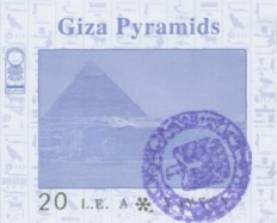 We all take the mandatory camel ride with photos and video.
We all take the mandatory camel ride with photos and video.
We admire the Pyramids; there are nine of them: Chefren with the three smaller one for his children, Mikerinos, the only pyramid made of gray granite from Nubia, with also another three pyramids for his children and Cheops, like Chefren’s, made of yellow limestone. This pyramid, with its tip still covered with the original plaster, is the highest standing at 146 meters.
A young man offers his services
as a guide to a newly discovered tomb. Gamal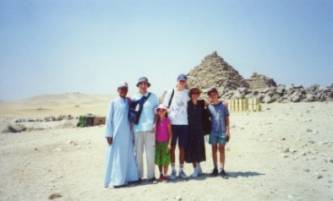 approves assuring me that the offer
is genuine, so we go visiting the new excavations. The man does not fit the
”entourage”, he is blond, tall, blond moustache, blue eyes and fair complexion
wearing a “galabija” and jogging shoes and walks ramrod stiff rather
than slouching like the people around. He could be a self-exiled Anglo-Saxon or
the son of an Englishman. Naturally his English is impeccable and accent less.
approves assuring me that the offer
is genuine, so we go visiting the new excavations. The man does not fit the
”entourage”, he is blond, tall, blond moustache, blue eyes and fair complexion
wearing a “galabija” and jogging shoes and walks ramrod stiff rather
than slouching like the people around. He could be a self-exiled Anglo-Saxon or
the son of an Englishman. Naturally his English is impeccable and accent less.
Then the Sphinx (4.500 years old, it represents the face of the pharaoh Kafre with body of a lion) and, as far as our guide and Gamal are concerned, it was Napoleon who ordered the mutilation of its nose rather than the Mameluks that used it for target practice, as history tells us.
The quality and beauty of the artifacts together with the evidence of building and artistic ability of the ancient Egyptians leave us speechless.
Gamal makes a point of returning to me his “percentage” of the various “baksheesh” that I had given to guides, camel drivers and who in turn surreptitiously handed him a “kickback”. Obviously I take good note of that.
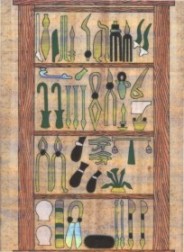 He then takes us to a shop where after offering us a cool drink and a
bit of pleasant chitchat we are shown the process of making papyrus and some
completed ones. Amazingly one of them depicted orthodontic instruments! Gamal
in the meantime, lays down on a sofa, closes his eyes and loses himself in the
pleasures of a “narghilè”. We leave after some bargaining and
purchasing, smiles and handshakes and just before pulling away, the shopkeeper
catches up with us and gives my daughter a papyrus bookmark as a gift. This is
but a small demonstration of courtesy and cordiality typical of the Egyptian
hospitality.
He then takes us to a shop where after offering us a cool drink and a
bit of pleasant chitchat we are shown the process of making papyrus and some
completed ones. Amazingly one of them depicted orthodontic instruments! Gamal
in the meantime, lays down on a sofa, closes his eyes and loses himself in the
pleasures of a “narghilè”. We leave after some bargaining and
purchasing, smiles and handshakes and just before pulling away, the shopkeeper
catches up with us and gives my daughter a papyrus bookmark as a gift. This is
but a small demonstration of courtesy and cordiality typical of the Egyptian
hospitality.
We spend the afternoon at the hotel with a few hours near the pool whilst the song “Mustafa” is endlessly played over the “piped music” system. In the evening the pool is transformed into a beautiful illuminated fountain and dinner is served around it.
The desire of revisiting Alexandria has become so strong that I decide to leave the next day and postpone to a next trip other sights of interest in Cairo.
Gamal takes the desert super highway boasting six lanes all the way to Montazah. The Rest House has been renovated and modernized and I am pleased to note that a good irrigation program has resulted in orchards and other fruit tree plantations practically all along the way. In Alexandria, just before Lake Mariut, a large number of factories and refineries, old and new salt mines dot the horizon and a new road, parallel to Ramleh, takes us all the way to Aboukir. The road is strewn with potholes and bumps, some apparently as high as 20cm, that cars, including ours with some muttering from Gamal, cannot avoid hitting. It is rather unsettling seeing car drivers leaning outside their window and asking other drivers for information whilst driving at 100 km p/h, trying to steer a straight course, drifting sideways and applying sharp corrections when returning their attention to the road ahead!
Before that, Gamal gave us his wife regards and told us that his son would have liked to join us so he could get to meet my kids. When we reach our destination and after having received an adequate “baksheesh” he hugs me, kisses my cheek and whispers “zai ahuia”. I return the hug willingly
Montazah
The complex is very well maintained and an entrance fee is levied to restrict visitors. In the evening when taking a walk in the immaculately kept lanes, one feels safe. Our eyes feast on the calm sea reflecting a clear sky and its surface barely rippled by a breeze carrying a gentle waft of seaweed. Our lungs fill with fresh air and a sensation of peace and tranquility pervades us. Mentally I remember and regret losing all the things that we did not know how to appreciate years ago.
A number of tourism-oriented businesses are nearly empty, from the Casino, hotels at 500 US $ per night to the open-air cafes with the staff apparently aimlessly running up and down for no specific purpose.
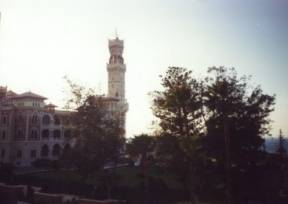 The Palestine used to be a good hotel with an unequalled panoramic view,
however, wear and tear shows its age and it is in urgent need of restoration.
It is primarily patronized by Cairots and Egyptians working and living in the
Gulf States. The food is average and is worth about half the bill that comes
with it, however, the staff is polite and well mannered. Efficiency could be
improved. It took close to twenty minutes to get our bill, three attempts with
three different results to get it done. Both the cashier and I decided that the
result of the third trial was OK, not because it was correct but because he was
getting annoyed and I had to leave for Cairo, where Egypt Air waited to take us
back to Rome, with Mando’s very comfortable and
air conditioned Peugeot. Mando is a very modern driver with a nice clean car
and a mobile phone 0123-465104. Of course he speaks English very well, is very
courteous with eastern looks, light skin, slightly receding hairline, elegant
features and the unfailing elegant moustache.
The Palestine used to be a good hotel with an unequalled panoramic view,
however, wear and tear shows its age and it is in urgent need of restoration.
It is primarily patronized by Cairots and Egyptians working and living in the
Gulf States. The food is average and is worth about half the bill that comes
with it, however, the staff is polite and well mannered. Efficiency could be
improved. It took close to twenty minutes to get our bill, three attempts with
three different results to get it done. Both the cashier and I decided that the
result of the third trial was OK, not because it was correct but because he was
getting annoyed and I had to leave for Cairo, where Egypt Air waited to take us
back to Rome, with Mando’s very comfortable and
air conditioned Peugeot. Mando is a very modern driver with a nice clean car
and a mobile phone 0123-465104. Of course he speaks English very well, is very
courteous with eastern looks, light skin, slightly receding hairline, elegant
features and the unfailing elegant moustache.
We were in room 333 and whenever I needed something I quoted the room number as “talata, talata, talata” which to me is quicker than “toltomeja talata u talatin”, and naturally by then I told whoever was half willing to listen, that I was from Alexandria. I was rather pleased when one day I overheard two staff members referring to me as “El iskandarani min el oda talata talata talata”! (rather than “El hawaga” or even “A franghi”).
The evening offers a lot of open-air entertainment in particular film
comedies playing at maximum volume. Egyptian spectators are very polite, they
smile at the jokes in contrast to the actors that laugh loudly and
uncontrollably. It so happened that during our visit a number of weddings took
place and every evening beautiful carpets were laid on the sand and guests reveled
with
small songs and toasts; the bride and the groom took happy snaps inserting
their heads in cut-outs depicting King Farouk and his first wife Queen Farida.
playing at maximum volume. Egyptian spectators are very polite, they
smile at the jokes in contrast to the actors that laugh loudly and
uncontrollably. It so happened that during our visit a number of weddings took
place and every evening beautiful carpets were laid on the sand and guests reveled
with
small songs and toasts; the bride and the groom took happy snaps inserting
their heads in cut-outs depicting King Farouk and his first wife Queen Farida.
I only saw two English couples and met a French one in the elevator who, to our Italian speech, commented “Ce sont les premiers étrangers que je vois”, to which I replied: “moi aussi”.
As I was swimming in those clear and welcoming waters with my children, a very pleasant man from Cairo asked me in English “Are you Russian?” rather surprised I answered ironically “Not yet!” He carried on asking all sorts of questions about us, what were we doing there, what was my job, etc… He then introduced me to his young pretty wife and his friendly son Boutros.
I was later told that Egypt was full of Russians (and Filipinos) trying to find employment with affluent families, restaurants, bands as well as a number of females offering their services as dancers. The irony of it is that forty years ago the Russians entered Egypt as conquerors and now their progeny goes there hoping to serve the Egyptians.
The beaches
Beaches along the Corniche are all polluted. Three and a half million people, with a per capita consumption much higher than forty years ago, and only four old and insufficiente waste water treatment plants have something to do with it. One can bathe at Montazah, Maamourah, Ramleh El Bedah (which apparently is reserved for the army officers, their families and friends).
A series of holiday estates line the beaches from Burgh El Arab to El Alamein. Our friend Nino Licciardello goes all the way to Marsah Matrouh to enjoy his summer vacations.
At Sidi Bishr you can still find the Devil’s Well (Bir El Shetan) but it is much closer to the shore as a lot of beach was reclaimed to widen the Corniche. The old “Chalets” have all been razed to the ground and replaced by skyscrapers. In Stanley, the large bay, is practically closed due to the construction of a bridge also part of the Corniche improvements. The San Stefano casino is no longer there and one by one all buildings that are on the beach side of the road are demolished: the new Corniche must have an unobstructed view of the sea. Glymenopoulo is now Glym.
At Montazah one sinks peacefully in its welcoming waters either in front of the Hotel Palestine or in any of the adjacent beaches. The water, of a magnificent emerald green, is nice, clean and saltier than I remembered. The sand is coarse with large yellow grains that I have not seen anywhere else.
As in the old days there are a lot of restaurants on the waterfront and
at Stanley you can even find a McDonald’s. Our Egyptian friends took us to a
nice restaurant at Miami on the Corniche; a copious “Mezze” filled with
all the delicacies that we remember, “Foul”, “Falafel” and to top it all
Mango juice!
I used to live in Mazarita, opposite Luna Park, facing the Eastern Bay
not far from the Kaid Ibrahim Mosque. Restoration and modernization transformed
the block of units into a shining white building, with balconies painted 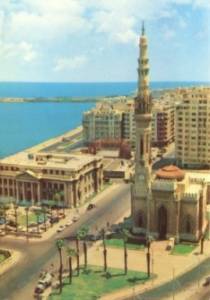 Egyptian green, that preens amidst the more modern constructions. I introduce
myself to the “bawab” who welcomes me and introduces me in turn to his
family with an abundance of handshakes. He remembered fondly our two old “bawab”
Mohamed and Mahmoud and takes the opportunity to show off his son’s, a nice
young man of fifteen with a clearly delineated shadow of beard and moustache,
knowledge of English.
Egyptian green, that preens amidst the more modern constructions. I introduce
myself to the “bawab” who welcomes me and introduces me in turn to his
family with an abundance of handshakes. He remembered fondly our two old “bawab”
Mohamed and Mahmoud and takes the opportunity to show off his son’s, a nice
young man of fifteen with a clearly delineated shadow of beard and moustache,
knowledge of English.
Aboukir, instead, is a big disappointment. Two harbors, one military and the other commercial, block access to the water and the fish markets emanate unbearable odors.
There’s supposed to be a museum displaying artifacts
from the naval battle between the French and the English but  considering that
two of my children are not feeling well, we have to return to the hotel. They
are starting to display marked signs of the Pharaoh’s Curse, the classic tummy
ache, that got us despite our precautions when selecting food and beverages.
considering that
two of my children are not feeling well, we have to return to the hotel. They
are starting to display marked signs of the Pharaoh’s Curse, the classic tummy
ache, that got us despite our precautions when selecting food and beverages.
Relative to Aboukir we recall that on the 1st and 2nd of August 1798, the French fleet of seventeen ships, under the command of admiral Francois Paul Brueys d'Aigailliers, who transported Napoleon Bonaparte and his army from Toulon to Egypt was taken by surprise by the English admiral Horatio Nelson commanding a fleet of 14 ships.
The English attacked at twilight and
caught the French totally 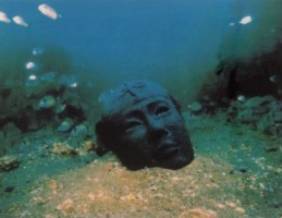 unaware at anchor, near the beach, some boats even
careened onto the beach. With no possibility of maneuvering the French fleet
was decimated. The battle lasted all night and only four French ships,
that later surrendered and were sunk, managed to escape the trap.
unaware at anchor, near the beach, some boats even
careened onto the beach. With no possibility of maneuvering the French fleet
was decimated. The battle lasted all night and only four French ships,
that later surrendered and were sunk, managed to escape the trap.
Other highlights in Aboukir are the remains of the ancient city of Canopus where important historical information were discovered under water.
Don Bosco
A quick look at the Italian Consulate at Muhatta Ramleh and then up Safia Zaghloul street. The Alhambra is in a basement, the Elite looks more like a rat trap and the Metro cinema looks like it has shrunk.
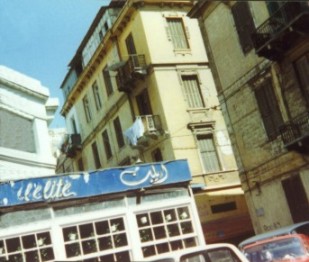 |
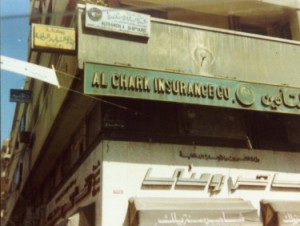 |
Then down Rue Fuad (a lot of people still refer to it by that name), the Amir, Pastroudis, the Strand and opposite what used to be my father’s office, which by a strange coincidence houses the offices of a navigation company (my father was the main shareholder of the Company “Llyod Mediterraneano Italo-Egiziano”).
One more stop at the St. Caterina Cathedral and the guided tour given by an Italian who is the priest’s assistant and a Greek acting as the Italian personal assistant, the inevitable “baksheesh” for both of them even though the Greek personal assistant did absolutely nothing, the grave of Vittorio Emmanuele III all of it rekindling memories of Sunday masses and my favorite cousin’s wedding. Finally Rue Khedive I, now called Rue Cherif (the old Rue Cherif should be called now Sharah Tawfik) and eventually the grand and mythical Don Bosco.
What a joy to see this college once again! What a surge of emotions and affection. It is amazing how the Salesian Brothers managed against all odds to keep this school going, from kindergarten to high school, 1.200 students the grand majority of which are Egyptians. Egyptian friends spoke to us of Don Bosco as an Elite school in Alexandria.
As soon as we enter we see the typical little group of people in a huddle smoking and chatting, some of which wear the “galabija”. Hard and harsh faces of people used primarily to manual labor. Faces that look as if they’ve been carved with a chisel and definitely do not belong in this environment. I ask for Don Russo, who appears a few seconds later. Don Russo has an aristocratic deportment with soft and gentle features, of advanced age but still emanating the authority of a person used to command and decision-making. All present rise out of respect.
I am shocked by these contrasts. Don Russo is pleased when I hand him some photos sent by Mario Giordano and he confesses, later, that the gratitude and affection displayed by a large number of former students helped him overcome various administrative problems of the school. He invites us to his office, offers us cooling drinks and talks about today’s school and some of the brothers and priests that I used to know.
The meeting with the principal and his assistant is also very pleasant and is followed by a visit to the school chapel, (nothing has changed: the paintings of Don Bosco and Domenico Savio remind me of the countless hours that I spent there trying to imagine them as they were described to us), the athletics field, the various competitions, the classrooms, the gray buses and the “fights” with the older boys, the Amante brothers, the very much missed Marcello Casco, all come back in a flash!
Now I understand that what we took as extreme severity was nothing more than dedication to the vows taken by the Salesian Brothers. Today my respect for their order is even greater.
Visiting the chapel I remembered a semi comical episode. I was serving
Easter solemn Mass,  with three priests, and had to go from the sacristy to the
altar carrying a big and heavy lit candle. The flame however was almost
touching the velvet dais (which is no longer there) so, to lower it, I leaned
the candle backwards and the melted wax dripped on my eye burning my eyelid and
eyebrows. I staggered from the pain and the priest following me said, “come
on, you must
not falter, keep the pace, you must be the first one to enter!” My friends
later remembered this moment as an act of misplaced gallantry, however my eye
burned like hell and I could do nothing about it until the end of the mass!
with three priests, and had to go from the sacristy to the
altar carrying a big and heavy lit candle. The flame however was almost
touching the velvet dais (which is no longer there) so, to lower it, I leaned
the candle backwards and the melted wax dripped on my eye burning my eyelid and
eyebrows. I staggered from the pain and the priest following me said, “come
on, you must
not falter, keep the pace, you must be the first one to enter!” My friends
later remembered this moment as an act of misplaced gallantry, however my eye
burned like hell and I could do nothing about it until the end of the mass!
Italian cemetery in Alexandria
The Italian cemetery is situated on the then Rue d’Aboukir, subsequently renamed Sharah El Horreja and now Sharah Gamal Abdel Nasser, however not even taxi drivers refer to it by that name. One worker removed weeds and another watered the plants but their combined efforts did not dent the overall state of abandonment and neglect.
I asked the keeper, a young man equipped with the standard “bureaucratic toolkit” (a chair and small wooden desk) to show me the cemetery registers and he looked at me stupefied and rather annoyed and told me that they did not exist (I must have disturbed the repose of his mind). When I insisted he asked me to come back the next day and in the meantime he would ask the “Moudir”.
Forgetting the alive but useless keeper, I followed my mother’s instructions and found the ossuary housing the remains of my maternal grandfather, Mario Flavetta who passed away the 5th of April 1953 and of my paternal uncle Gennaro De Martino who died on the 28th of September 1960. I said a prayer for them.
Rage took hold of me when I discovered that my paternal grand parents graves, that used to be covered with beautiful marble lids, had been vandalized. I can only think of one reason: someone needed the marble.
The ossuary and crypts show only signs of age and neglect, they are in precarious but acceptable conditions, though the walls of some crypts show only the rough surface of the brick wall and some graves are only covered with dirt. It looks exactly what it is: a place after forty years of neglect! I know that some people, out of a sense of charity and compassion, have done and still do a lot but it is not enough!
Vittorio Emmanuele III retirement Home
As I remembered it, it is at Soter and the building still stands proud and elegant. I read the names of some of the benefactors, some of which I recognize: Giannotti, Cartareggia and Misitano.
Mr. and Mrs. Patruno do their best to provide for the needs of the residents. Mr. Nino Licciardello is desperately trying to handle a situation that went out of control particularly after the Nigrizia Nuns left. They are beautiful old people who refused to leave the country of their birth in which they still have faith. There is a certain nobility in their attitude and their perception of “us who could not stand the heat and left the kitchen”. I take my hat off to them!
Whilst waiting for us in the garden, Mohamed Ali, our driver, spoke to a few residents and told me later “It is incredible, they love Egypt more than me! If I get the time I will come and spend it with them; I’m learning so many things about my country from you foreigners, things I did not even know they existed!”
El Alamein
It means “the two peaks.” The road is wide, well paved and maintained and is dotted with police posts for the control of transit documents. Only one adjective can be used to describe the sea “splendid” and this encouraged the building and proliferation of a high number of expensive, when taking into consideration the local standard of living, holiday and summer residences. I was told that a medium sized apartment is worth about 250 million Italian Lira (125.000 US $).
In the midst of undulating sand hills, the German mausoleum, a stumpy tower, is really out of place. A bit further on, the Egyptian Museum is the storage and display place of weapons recovered from the battlefields. It is definitely well organized and also offers the visitor a bar with cooling drinks. On the downside, I found out of place the demand for a fee equal to five adults entrance tickets, for the use of the video camera.
In this museum more than anywhere else one can grasp the magnitude of the battlefield and the people involved; on one side Germans, Italians and Libyans and the other Australians, British, Canadians, French, Egyptians, Greeks, Indians, Moroccans, Pakistanis and a multitude of Africans enrolled from various French and English colonies.
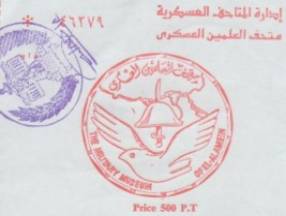 |
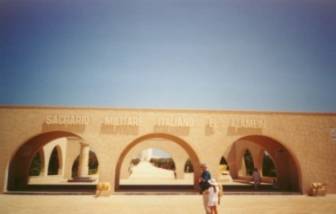 |
Then the Italian Mausoleum (my uncle was in the building team) and Quota 33. A lot of words were written on the subject, words far more appropriate than mine. I only wish to say that I felt a high degree of sadness for all those losses of human lives (both Allied and Axe), but also the pride in having the same lineage as the Italians buried there.
The Streets.
You do not see many buses and trams, however there is a plethora of private vehicles (station wagons, mini buses, vans both closed and open and in Aboukir you can even see nicely painted carts pulled by mules or horses).
Even though the traffic flows better than in Rome, one cannot entertain
the thought of hiring and driving a car. All traffic signs are in Arabic, pedestrians
are worse than motorbikes and the anxiety of having an accident and having to
talk your way out of it, is foremost in your thoughts. 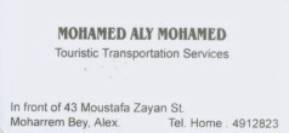 Our driver, Mohammed Ali
(who lives in Moharrem Bey and answers to the 491.2823 phone number) is an
experienced driver and an honest person. He does not come cheaply, and neither
should he, but carries out his work with competence, respect and dignity and
has that “je ne sais quoi” that very quickly gets me to think of him as a
friend. Mario Giordano and Lucia Zottich met him before me and were unanimous
in their praise and appreciation. He is of medium stature, rather stocky with
an open face and an intelligent look. He is a “solid man” that reminded me of
the “camalli” from Genoa. He is a very
versatile jack of all trades, as a seaman he traveled the world and prior to
that he worked at the textiles factory of Mr. Polvara. Now he drives a Peugeot
505 station wagon with over 350,000 Km
Our driver, Mohammed Ali
(who lives in Moharrem Bey and answers to the 491.2823 phone number) is an
experienced driver and an honest person. He does not come cheaply, and neither
should he, but carries out his work with competence, respect and dignity and
has that “je ne sais quoi” that very quickly gets me to think of him as a
friend. Mario Giordano and Lucia Zottich met him before me and were unanimous
in their praise and appreciation. He is of medium stature, rather stocky with
an open face and an intelligent look. He is a “solid man” that reminded me of
the “camalli” from Genoa. He is a very
versatile jack of all trades, as a seaman he traveled the world and prior to
that he worked at the textiles factory of Mr. Polvara. Now he drives a Peugeot
505 station wagon with over 350,000 Km 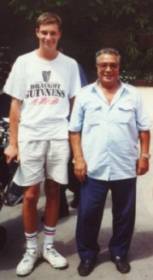 on the clock that runs like a dream, to
quote him, “as long as you service it regularly and check the oil level”... The
car is very neat and clean. He took us around Alexandria and everyday he had a
little “something” for us; biscuits cooked by his wife for the kids, nice fresh
guavas, hibiscus flowers for the “carcadè”, fresh small green lemons
scenting the air, etc.
on the clock that runs like a dream, to
quote him, “as long as you service it regularly and check the oil level”... The
car is very neat and clean. He took us around Alexandria and everyday he had a
little “something” for us; biscuits cooked by his wife for the kids, nice fresh
guavas, hibiscus flowers for the “carcadè”, fresh small green lemons
scenting the air, etc.
The streets are in general well paved, some with the old pavé, but overall pot holes are few and far in between (and we cannot help noting that in Rome it is difficult to find a street without pot holes). Major streets are all kerbed and guttered with footpaths, that unfortunately are not always clean. Side street are often covered with a mixture of coarse sand and dirt. Main roads are divided but are congested with donkey carts that follow the same rules as the pedestrians i.e. none. When faced with a young man hitting a donkey that could not pull the cart over the lane divider, Mohammed Ali muttered “min el humar?” Speed limits and parking restrictions in the main streets are respected, primarily due to the threat of loss of license and/or the severe drubbing inflicted on the vehicle panels by infuriated “shaouish” yielding batons!
Alexandria has four old insufficiente sewage treatment plants. All sewer pipes run under the streets and some straight to the sea and it happens that when crossing a particular street, where the sewer pipes are damaged, one gets assaulted by a heavy miasma, this also happens very unfortunately near the fish markets and close to the garbage collection points.
Whilst the “corniche” and the houses facing it glitter in the sun (I am still blinded by the brightness of the villas in Glym) suburban streets and the old houses in the historic centre of Alexandria require a lot of work and restoration. The cement rendering, or whatever little is left, of the houses of “Sharah Sabaa Banat” is of a dirty gray and all shutters hang on for dear life; few “musharabija” are still left. The efforts done in the past to wipe out all traces of a cosmopolitan Egypt, including the "prohibition" of wearing the “tarbush”, are responsible for the erasure of a special and unique chapter out of the history of this beautiful country.
There is a high incidence of repair shops , as opposed to shops selling
new articles. Nothing is thrown away, things are repaired and recycled and you
can see the most unimaginable bits waiting to be re-used: parts of electric
irons, radio knobs, cassettes without tapes, locks and keys, bicycle lights,
car fenders, car tires of every size and brand, chairs, etc.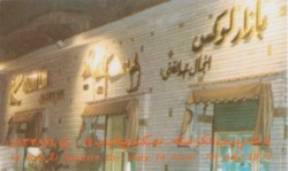
Souvenir shops in the Souk or Bazaar, are particularly interesting and in them you can find a plethora of nice and interesting souvenirs that I bought for friends and relatives. I also purchased a Tarbush! I recommend you visit LUX in Sharah Bab El Karasta!
Ras El Tin and Kait Bey
I can say little of the Ras El Tin Palace, as it is the Rais residence when he is in Alexandria and is treated by the police as if it was a military installation. This palace was taken over during the revolution in 1952 when army officers headed by General Neghib forced King Farouk to abdicate, in favor of his son Fuad II, and sail on his yacht to Italy.
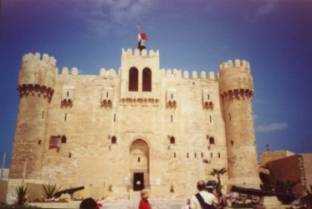 |
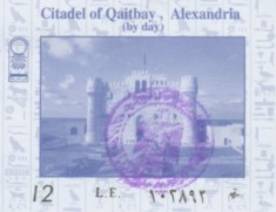 |
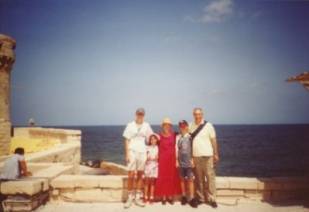 |
Kait Bey castle is being restored and stands white and majestic against the beautiful blue Egyptian sky. On this site, in 300 b.C., stood the Faros of Alexandria, one hundred and twenty metres high to be visible for sailors due to the flatness of the Egyptian land, it was considered one of the seven wonders of the world. It was later on destroyed by various earthquakes the last one around 1300. A mosque was built on its remains, using the same blocks of sandstone, later on the fort we all know was erected.
A small but interesting museum displays maritime artifacts dating from ancient Egypt to the Arab conquerors and to the Napoleonian French.
Cafes, restaurants and Theatres.
They used to be our main meeting and reference points: Pastroudis is still there unweathered by time, Delices still makes the best cakes, Athineos and the Trianon lost some of their luster whilst the Elite is pitiful in its decay.

Of the restaurants I can say little except that I spotted some familiar names and that hotel restaurants are too expensive. On the other hand, the Mex Seagull restaurant offers very tasty meals and excellent service at a much more reasonable tab.
The movie theatres that looked so grand in our youth look very diminutive but are all there. Now as in the past they advertise the movie of the day and the coming attractions.
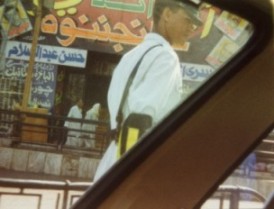 |
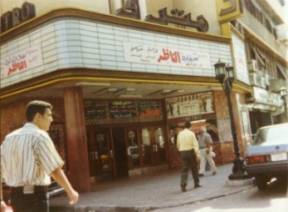 |
The pictures display the Elabd theatre at Ibrahimieh and the Metro cinema in the city.
The library.
Still under construction it should be ready in the current calendar year. It will certainly be a big attraction for Alexandria, a city with a history and culture that unfortunately very few people know.
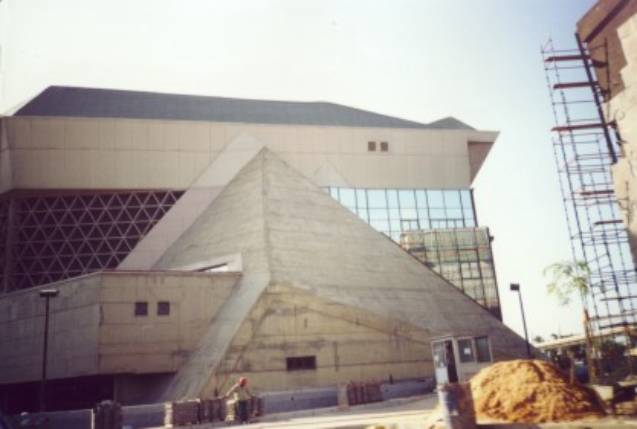 |
It is said that the library was developed in Alexandria mainly due to its high production and availability of papyrus. It could be true, however it would be more accurate to attribute its development to the number of people requiring text to be written and artisans capable of doing so.
It is said that in the II century b.C. there was a plan to increase production from 200,000 to 500,000 papyrus and that during the days of “Callimacus” (circa 250 b.C.) there were 100,000 texts between the ones in the palace and the ones in the library. Together with Athens and Antioch it was certainly the world symbol of Hellenic culture.
Julius Caesar was accused of setting fire to it but it makes more sense to attribute its loss to a series of events during the decline of the city, such as the Roman reprisals of Jewish insurrections during the third and fourth century and its final destruction at the beginning of the Arab occupation.
Hospitality
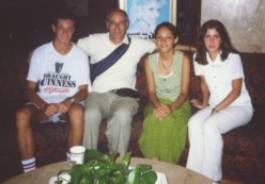 The Egyptian hospitality is legendary and whatever I say can only
enhance that reputation. We were guests of Egyptians that we met trough a
fortunate event, and
the hospitality they bestowed upon us is one of the highlights of the whole
trip. It is obvious to me that the Egyptian takes pleasure in pampering and
showering his guests with presents. Two things often come to my mind of my trip
to Alexandria: the sea and the hospitality.
The Egyptian hospitality is legendary and whatever I say can only
enhance that reputation. We were guests of Egyptians that we met trough a
fortunate event, and
the hospitality they bestowed upon us is one of the highlights of the whole
trip. It is obvious to me that the Egyptian takes pleasure in pampering and
showering his guests with presents. Two things often come to my mind of my trip
to Alexandria: the sea and the hospitality.
The flavours
The very salty taste left on the lips after a swim
Fish with a very light flavour, almost sweet
The small fresh and fragrant green lemons
Pistachio
Leb
Sudani
Sesame couluria
“La vache qui rie” cheese
Various dishes of the past, such as:
Mouloukhia
Tehina
Babaghannoush
Bamiah
Foul
Falafel
Various sweets and cakes:
Loucoumades
The jelly brand “Gello” with the taste of cherry
Fruits:
Mangoes, its juice and ice cream
Guavas
New season dates
Sugar can juice
“Ahwa sukkar ziada” and “mazbout”
The Aromas
Guavas
Jasmine flowers
The feminine lemon scent perfume
The briny and slight rusty taste of the sea breeze
As well as:
Lamb roast
Food fried with samna
The heavy smell of fish at the markets
The tang in some side street
The sounds
In the cacophony and general turmoil one can detect:
The muezzin’s prayers now recordings spewed by blaring speakers
The
tonalities of Arabic songs and the music that we no longer hear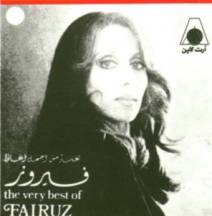
Car horns
The noise of exhaust pipes with holes
The howling of women to celebrate a wedding
Car radios and home TV playing at full volume and the plethora of satellite dishes
The Egyptian accent which is so reminiscent of that of the Italians born in Egypt
The blue and white taxis of Cairo and yellow and black of Alexandria
The light blue of the sky and the intense and limpid blue of the sea
The yellow of the sand in Alexandria and the white of the sand in El Alamein
The gray white colour of the desert with its greenish plants
The brilliant white of the villas in Glym (previously Glymenopoulo)
The Clothing
Few galabiyeh and no tarboushs
Some burnitas
A lot of white uniforms for:
The shaouish
The traffic police
The military
Special police
In black however all the anti terrorism special squad, heavily armed and present at all tourist venues.
Men dressed in European style with a light material jacket and matching pants.
Women up to date with the European fashion (but longer skirts), at times with the addition of a gentle veil covering their hair.
At times, the one-piece female swim suits covering the whole body with the exception of hands and feet.
Sense of hospitality
The art of pleasing
The ritualistic salutations at meeting be it friendly or business
The ever present and unavoidable “baksheesh”
The chasing of the “short term” profit
The annoying red tape of Egyptian bureaucracy
The absolute confusion and lack of organization in all aspects of business (hotels, airports, travel agencies, public offices), and if the traffic flows, certainly better than in Rome, it is mainly due to the diligence and presence of a strong contingent of policemen.